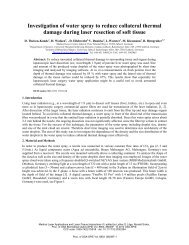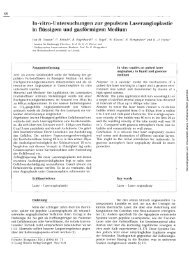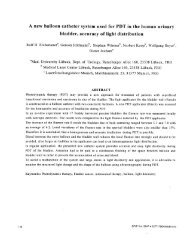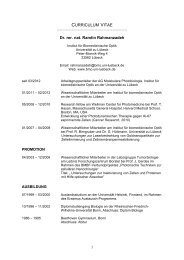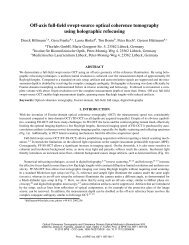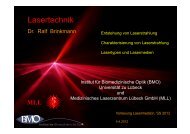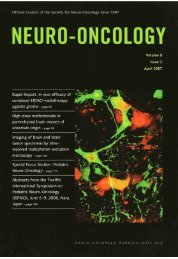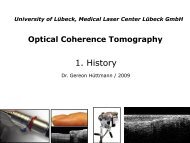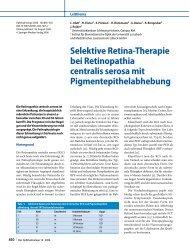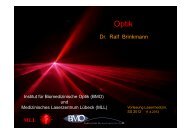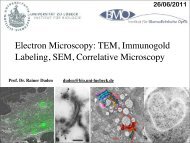Invited p aper Mechanisms of femtosecond laser nanosurgery of ...
Invited p aper Mechanisms of femtosecond laser nanosurgery of ...
Invited p aper Mechanisms of femtosecond laser nanosurgery of ...
Create successful ePaper yourself
Turn your PDF publications into a flip-book with our unique Google optimized e-Paper software.
VOGEL et al. <strong>Mechanisms</strong> <strong>of</strong> <strong>femtosecond</strong> <strong>laser</strong> <strong>nanosurgery</strong> <strong>of</strong> cells and tissues 1039Pulse Energy Repetition Dwell time Number Electron Volum. Irradiance NormalizedEffect duration (nJ) rate (ms) <strong>of</strong> density energy (×10 12 irradiance(fs) Average pulses (cm −3 ) density W cm −2 ) I/I rateNA power per spot (J cm −3 )(1) One free 100 Single – 1 2.1 × 10 13 4.9 × 10 −5 0.26 0.04electronpulseper pulse 1.3(2) Chemical cell 0.6damage after 90 0.0875 80 MHz per cell 4.8 × 10 4 1.5 × 10 14 3.5 × 10 −4 0.44 0.067scanning irrad. per cell for one[144] 1.3 7 mW pulse(3) Intranuclear 170 0.38 80 Mhz 0.5 per 4 × 10 4 2.0 × 10 16 4.7 × 10 −2 1.0 0.15chromosome chromosome for onedissection 1.3 dissection pulseat 80 MHz [4]30 mW(4) Cell trans- 170 0.6–1.2 80 MHz 12 9.6 × 10 5 5–200 1.2–47 1.6–3.1 0.25–0.48fection ×10 17 for oneat 80 MHz [53] 1.3 50–100 mW pulse(5) ∆T <strong>of</strong> 100 ◦ C 100 80 MHz ≥ 0.1 ≥ 0.8× 2.1 × 10 19 50 3.3 0.51after many 10 4 for onepulses 1.3 pulse(6) Bubble 100 Single – 1 2.36 × 10 20 551 5.1 0.78formationpulsein pure water 1.3(7) Bd threshold 100 – 1 1.0 × 10 21 2.6 × 10 3 6.54 1in numericalmodels(8) EYFP-tagged 100 2 1 kHz > 100 Several ≥ 10 21 ≥ 2.6 × 10 3 10.5 1.6mitochondrionhundredablation 1.4at 1 kHz [85](9) Axon 200 10 1 kHz 400 400 ≥ 10 21 ≥ 2.6 × 10 3 52 8.0dissection inC. elegans 1.4at 1 kHz [79]TABLE 2 Numerical values <strong>of</strong> the data presented in Fig. 21. All data refer to a <strong>laser</strong> wavelength <strong>of</strong> λ = 800 nm, and water as breakdown medium. Theexperimental irradiance values assume diffraction-limited focusing conditions and a perfect <strong>laser</strong> beam. They refer to the peak irradiance in the <strong>laser</strong> focus(≈ 2× average irradiance within the spot diameter) to make them comparable with the calculated values. The actual irradiance in the experiments is probablysomewhat smaller than the values calculated under these assumptions. For superthreshold irradiance values, the plasma will grow in size, and plasma shieldingand reflection will limit the growth <strong>of</strong> the free-electron density. Therefore, no exact values <strong>of</strong> the electron density and energy density are giventhat the intracellular ablation produced by long trains <strong>of</strong><strong>femtosecond</strong> pulses in the low-density plasma regime relieson cumulative free-electron-mediated chemical effects.This hypothesis is supported by the facts that the individualpulses produce a thermoelastic tensile stress <strong>of</strong> only≈ 0.014 MPa, and a pulse series <strong>of</strong> 100-µs duration resultsin a temperature rise <strong>of</strong> only ≈ 0.076 ◦ C.Thesevaluesfor tensile stress and temperature rise are far too small tocause any cutting effect or other type <strong>of</strong> cell injury. Thebreaking <strong>of</strong> chemical bonds, as described in Sect. 4, mayfirst lead to a disintegration <strong>of</strong> the structural integrity <strong>of</strong>biomolecules and finally to a dissection <strong>of</strong> sub-cellular structures.Bond breaking may be initiated both by resonant interactionswith low-energy electrons, and by multiphotonprocesses <strong>of</strong> lower order that do not yet create free electrons[4, 202–204].Interestingly, transient membrane permeabilization forgene transfer (4) requires a considerably larger <strong>laser</strong> dosethan chromosome dissection. Not only is the irradiancelarger, but the number <strong>of</strong> applied pulses (≈ 10 6 )als<strong>of</strong>arexceeds the quantity necessary for chromosome dissection(≈ 4 × 10 4 ). Chromosome dissection may be facilitated by theDNA absorption around 260 nm enabling nonlinear absorptionthrough lower-order multiphoton processes. Moreover,while breakage <strong>of</strong> relatively few bonds is sufficient for chromosomedissection, the creation <strong>of</strong> a relatively large openingis required for diffusion <strong>of</strong> a DNA plasmid through thecell membrane. The corresponding <strong>laser</strong> parameters are stillwithin the regime <strong>of</strong> free-electron-mediated chemical effectsbut already quite close to the range where cumulative heateffects start to play a role (5).At larger <strong>laser</strong> powers, bubbles with a lifetime <strong>of</strong> the order<strong>of</strong> a few seconds were observed that probably arise fromdissociation <strong>of</strong> biomolecules into volatile, non-condensablefragments [86, 88, 89, 205]. This dissociation <strong>of</strong> relativelylarge amounts <strong>of</strong> biomaterials can be attributed both t<strong>of</strong>ree-electron chemical and photochemical bond breakingas well as to accumulative thermal effects. The appearance<strong>of</strong> the bubbles is an indication <strong>of</strong> severe cell damageor cell death within the targeted region and defines anupper limit for the <strong>laser</strong> power suitable for <strong>nanosurgery</strong>.A criterion for successful intratissue dissection at lower energylevels is the appearance <strong>of</strong> intense aut<strong>of</strong>luorescencein perinuclear cell regions [86, 88] that is likely due tothe destruction <strong>of</strong> mitochondria at the rim <strong>of</strong> the <strong>laser</strong>cut [98].



